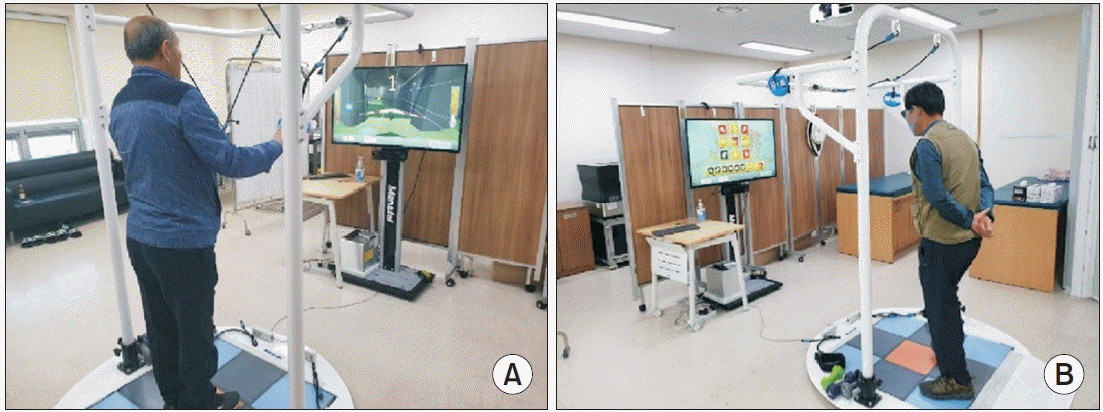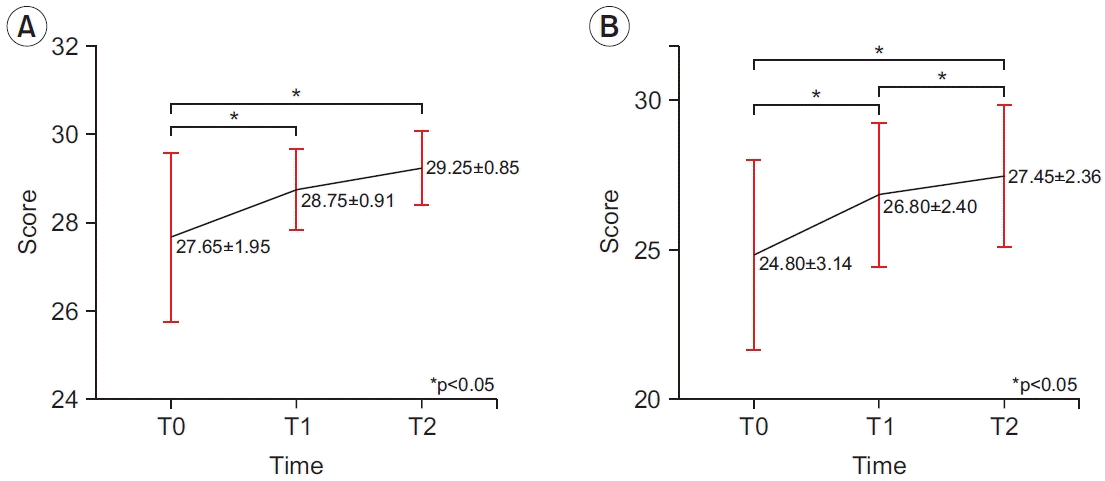1. Cohen H, Blatchly CA, Gombash LL. A study of the clinical test of sensory interaction and balance. Phys Ther. 1993; 73:346–54.

2. Horak FB, Shupert CL, Mirka A. Components of postural dyscontrol in the elderly: a review. Neurobiol Aging. 1989; 10:727–38.

3. Brooks VB. How does the limbic system assist motor learning? A limbic comparator hypothesis. Brain Behav Evol. 1986; 29:29–53.

4. Lord SR, Clark RD, Webster IW. Postural stability and associated physiological factors in a population of aged persons. J Gerontol. 1991; 46:M69–76.

5. Tinetti ME, Speechley M, Ginter SF. Risk factors for falls among elderly persons living in the community. N Engl J Med. 1988; 319:1701–7.

6. Meldrum D, Glennon A, Herdman S, Murray D, McConn-Walsh R. Virtual reality rehabilitation of balance: assessment of the usability of the Nintendo Wii Fit Plus. Disabil Rehabil Assist Technol. 2012; 7:205–10.
7.
VR Ayoub
LC Edelman
. Adjustable tension device for use with a resistance band exercise apparatus. United States patent US 10,821,314. 2020. Nov. 3.
8. Matjacic Z, Johannesen IL, Sinkjaer T. A multipurpose rehabilitation frame: a novel apparatus for balance training during standing of neurologically impaired individuals. J Rehabil Res Dev. 2000; 37:681–91.
9. Cress ME, Buchner DM, Prohaska T, Rimmer J, Brown M, Macera C, et al. Best practices for physical activity programs and behavior counseling in older adult populations. J Aging Phys Act. 2005; 13:61–74.

10. Nied RJ, Franklin B. Promoting and prescribing exercise for the elderly. Am Fam Physician. 2002; 65:419–26.
11. American College of Sports Medicine. ACSM’s guidelines for exercise testing and prescription. 9th ed. Philadelphia, PA: Lippincott Williams & Wilkins;2013.
12. Cha EG, Lee EY, Yang JK, Chung GJ, Koh MH, Shin MJ. Efficacy testing of an integrated IT/game training program for community-dwelling older adults: a pilot randomized controlled trial study. J Korean Acad Rehabil Med. 2018; 8:22–33.
13. Nakamura Y, Tanaka K, Yabushita N, Sakai T, Shigematsu R. Effects of exercise frequency on functional fitness in older adult women. Arch Gerontol Geriatr. 2007; 44:163–73.

14. Jang HY, Lee JH, Lee SM. The analysis on the reliability and validity of Korean-version balance assessment tools. J Korean Soc Phys Med. 2017; 12:139–46.

15. Kim JH. Reliability and validity of gait assessment tools for elderly person. J Korean Phys Ther. 2009; 21:41–8.
16. Langley FA, Mackintosh SF. Functional balance assessment of older community dwelling adults: a systematic review of the literature. Internet J Allied Health Sci Pract. 2017; 5:13.

17. Duncan PW, Weiner DK, Chandler J, Studenski S. Functional reach: a new clinical measure of balance. J Gerontol. 1990; 45:M192–7.

18. Kang Y, Park JS, Yu KH, Lee BC. A reliability, validity, and normative study of the Korean-Montreal Cognitive Assessment (K-MoCA) as an instrument for screening of vascular cognitive impairment (VCI). Korean J Clin Psychol. 2009; 28:549–62.
19. Sturnieks DL, St George R, Lord SR. Balance disorders in the elderly. Neurophysiol Clin. 2008; 38:467–78.
20. Weirich G, Bemben DA, Bemben MG. Predictors of balance in young, middle-aged, and late middle-aged women. J Geriatr Phys Ther. 2010; 33:110–7.
21. Ryushi T, Kumagai K, Hayase H, Abe T, Shibuya K, Ono A. Effect of resistive knee extension training on postural control measures in middle aged and elderly persons. J Physiol Anthropol Appl Human Sci. 2000; 19:143–9.

22. Gillespie LD, Gillespie WJ, Robertson MC, Lamb SE, Cumming RG, Rowe BH. Interventions for preventing falls in elderly people. Cochrane Database Syst Rev. 2003; (4):CD000340.

23. McCurdy K, Langford G. Comparison of unilateral squat strength between the dominant and nondominant leg in men and women. J Sports Sci Med. 2005; 4:153–9.
24. Guimaraes JM, Farinatti PD. Descriptive analysis of variables theoretically associated to the risk of falls in elder women. Revista Brasileira de Medicina do Esporte. 2005; 11:299–305.
25. Blair SN, Dunn AL, Marcus BH, Carpenter RA, Jaret P. Active living every day. 2nd ed. Champaign, IL: Human Kinetics;2011.
26. Optale G, Urgesi C, Busato V, Marin S, Piron L, Priftis K, et al. Controlling memory impairment in elderly adults using virtual reality memory training: a randomized controlled pilot study. Neurorehabil Neural Repair. 2010; 24:348–57.

27. Barnes JN. Exercise, cognitive function, and aging. Adv Physiol Educ. 2015; 39:55–62.

28. Taaffe DR, Irie F, Masaki KH, Abbott RD, Petrovitch H, Ross GW, et al. Physical activity, physical function, and incident dementia in elderly men: the Honolulu-Asia Aging Study. J Gerontol A Biol Sci Med Sci. 2008; 63:529–35.

29. Lai CH, Peng CW, Chen YL, Huang CP, Hsiao YL, Chen SC. Effects of interactive video-game based system exercise on the balance of the elderly. Gait Posture. 2013; 37:511–5.

30. Chang KV, Hsu TH, Wu WT, Huang KC, Han DS. Association between sarcopenia and cognitive impairment: a systematic review and meta-analysis. J Am Med Dir Assoc. 2016; 17:1164.e7–1164.e15.

31. Yeung SS, Reijnierse EM, Pham VK, Trappenburg MC, Lim WK, Meskers CG, et al. Sarcopenia and its association with falls and fractures in older adults: a systematic review and meta-analysis. J Cachexia Sarcopenia Muscle. 2019; 10:485–500.

32. Sveistrup H. Motor rehabilitation using virtual reality. J Neuroeng Rehabil. 2004; 1:10.
33. Lopes JS, Machado AF, Micheletti JK, de Almeida AC, Cavina AP, Pastre CM. Effects of training with elastic resistance versus conventional resistance on muscular strength: a systematic review and meta-analysis. SAGE Open Med. 2019; 7:2050312119831116.

34. de Bruin ED, Schoene D, Pichierri G, Smith ST. Use of virtual reality technique for the training of motor control in the elderly: some theoretical considerations. Z Gerontol Geriatr. 2010; 43:229–34.
35. Li F, Harmer P, Fisher KJ, McAuley E, Chaumeton N, Eckstrom E, et al. Tai Chi and fall reductions in older adults: a randomized controlled trial. J Gerontol A Biol Sci Med Sci. 2005; 60:187–94.

36. Chang JY, Tsai PF, Beck C, Hagen JL, Huff DC, Anand KJ, et al. The effect of tai chi on cognition in elders with cognitive impairment. Medsurg Nurs. 2011; 20:63–9.
37. Kawanabe K, Kawashima A, Sashimoto I, Takeda T, Sato Y, Iwamoto J. Effect of whole-body vibration exercise and muscle strengthening, balance, and walking exercises on walking ability in the elderly. Keio J Med. 2007; 56:28–33.

38. Chulvi-Medrano I, Colado JC, Pablos C, Naclerio F, Garcia-Masso X. A lower-limb training program to improve balance in healthy elderly women using the Tbow device. Phys Sportsmed. 2009; 37:127–35.

39. Ogaya S, Ikezoe T, Soda N, Ichihashi N. Effects of balance training using wobble boards in the elderly. J Strength Cond Res. 2011; 25:2616–22.

40. Delbroek T, Vermeylen W, Spildooren J. The effect of cognitive-motor dual task training with the biorescue force platform on cognition, balance and dual task performance in institutionalized older adults: a randomized controlled trial. J Phys Ther Sci. 2017; 29:1137–43.








 PDF
PDF Citation
Citation Print
Print



 XML Download
XML Download